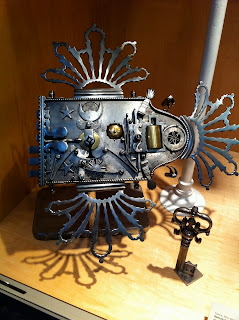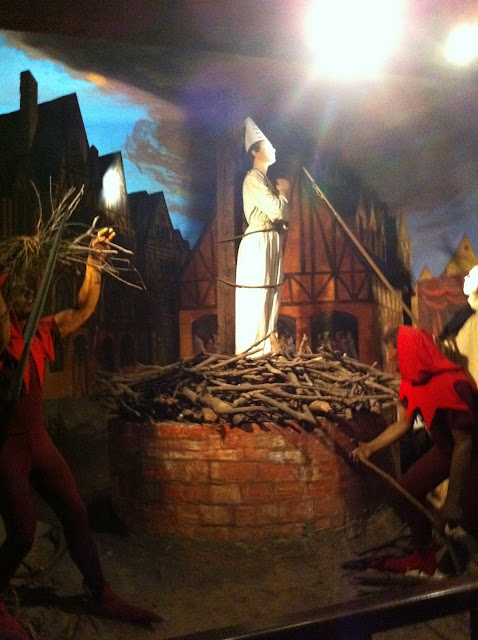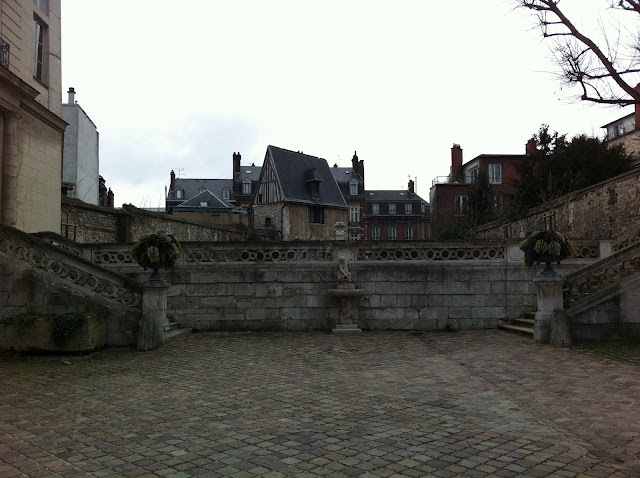When I need to get out of town for the day, sometimes I just log on to the SNCF (train system) website and see what runs me under 25 euros round trip. There's plenty to see in France within two hours of Paris, especially with the TGV. With cut-rate "Prem's" tickets and my Carte 12-25 youth discount, it's pretty easy to hop on almost anywhere, sometimes even at the last minute.
I wasn't looking for Rouen. Rouen found me.
For those of you who need a refresher on your French geography/history, Rouen is the city in Haut-Normandie where Jeanne d'Arc was burned at the stake. Consequently, besides several lovely museums and views immortalized by several notable impressionist painters, there's plenty to do in the saintly pilgrimage department, including several deeply impressive churches and a museum in her honor.
We'll get there.
But first, it's time to walk around.
 |
| The column on the left certainly took a beating. |
I walked past the Hôtel de Ville (every French city has one, and they're usually worth passing by), of which the most impressive feature was the huge holes that appeared to be made by some kind of heavy-duty ammunition. It turns out that, like many other buildings in Rouen, the Hôtel was badly damaged during the course of World War II.
I find the battered stone captivating. Look at that delicate carving above the door, and how solid that column looks save for missing chunks that look as they'd been removed with an enormous ice cream scoop. It reminds you that even that centuries-old stone isn't immutable.
 |
| The wet streets make it more lovely, don't you think? |
This enormous clock, appropriately named the Gros-Horloge, suspended above a street just off a main thoroughfare, is hard to describe. You turn the corner and boom! there it is, impressive and bright on an almost silent Sunday morning.
 |
| Underneath the clock. |
I had all day, the shops were closed (Sunday is quiet enough in Paris, but the rest of France seems to shut down almost entirely), so for a while, je n'ai que flâné, studying the eclectic buildings.
 |
| This was the most crowded of the streets I walked in my first hour or so. It was almost post-apocalypse quiet. |
I lingered outside my first stop on the cathedral circuit: Cathédrale Notre-Dame de Rouen. A mass was going on inside, so instead of staying to visit, I noted that there would be a guided tour at 14h30. Done.
 |
| Pretty glorious, even from outside. |
All three of the associated major art museums are free to the under-26 crowd, so naturally, among my first stops was Le Musée des Beaux-Arts.
 |
| A rather underwhelming-looking brunch was available. Almost worth it to sit in this warm, sunny garden. |
A sculpture garden sits under a skylight. On the other side is an enormous painting featuring a cocktail party where a long list of artists and visionaries are milling about. There's even a "who's-who" key.
Alongside the galleries of paintings by the standard old masters were a few modern installations.
 |
| I spent a lot of time around this one. It's like art museum playground equipment. |
 |
| I have no words for how much I love this. |
But I would be remiss in failing to show you a couple of famous impressionist paintings of Rouen, both of sights we have already seen so far.
 |
| La Cathédrale de Notre-Dame, Claude Monet |
 |
| Le Gros-Horloge, Léon-Jules Lemaître |
At one in the afternoon, the city was still sleeping. I'm used to a city in which the only time you can be lonely in the streets is in the wee hours, in a neighborhood in the double-digit arrondissements. Here, on a Sunday in broad daylight, one can walk for half an hour without crossing paths with a living soul.
The afternoon rolled by, and after eating a lunch that involved regional specialties such as intestinal sausages (never again, my friends) and Calvados, a liquor derived from apples, it was time to head to my guided tour.
 |
| I think it looks more interesting from the other side, where you can see the hodgepodge construction. |
 |
| Our meeting point. |
When the tour guide came to collect us, there were only three of us waiting: me, another American guy from New York, and an Italian woman: all of us currently living in Paris.
Our guide was a tiny middle-aged woman who clearly does this for the love of it. After giving us a brief overview of the mixed styles that comprise the cathedral over its centuries of evolution, she unlocked a side door and led us down a half-flight of stairs into this small, cold dark room, the oldest chapel in the cathedral, that dates from the 900's.
 |
| Check out the baptismal font with the wrought-iron cover! |
Back on the ground floor, she told us how to distinguish the original medieval stained glass from the windows added later: mostly blue, tiny pieces.
 |
| A little of both worlds. |
The old library stairs.
 |
| What style were they going for here? |
After pointing out various architectural styles and features in the main sanctuary, our guide once again took us through a gate, down a set of steps, and through a locked door into the Roman crypt.
 |
| For some reason, I found the well in the center particularly creepy. |
The cathedral was another building that suffered damage in World War II, and the uncovering of the crypt might have been the only good to come of the damage. In fact, some time before, a scholar was encouraging the excavation of what he was sure was a crypt of rich historical importance, but no one wanted to disturb the sanctuary. When that flank was ravaged, however, it exposed the crypt, and the excavation was finally achieved.
 |
| More ruins in the next chamber. |
We visited a line of statues, apparently the former occupants of niches above the doors of the cathedral in days of old.
 |
| In varying states of decay. |
A few old-school royals are entombed here as well.
 |
| A Roland, though I can't remember exactly who he was. |
I was glad to have had a guide, mes lapins. I swear that someday I'll read a solid book and learn the parts of the cathedrals. Until then, the sheer ornateness, age, and size of such cathedrals will continue to overwhelm my ignorant, if enthusiastic, sensibilities.
 |
| Can you blame me? I mean... wow. |
Next stop on the church circuit: L'Eglise Saint-Maclou.
 |
| Not so shabby either. |
Only steps from its big sister, the church seems almost nestled in the cozy surrounding streets. Not to say it's not magnificent, gorgeous, Gothic, etc. Just that its proximity makes it seem quite modest in comparison.
As I walked through, a woman was playing Gounod's Ave Maria on her guitar and singing--not very well, but with passion. There are things one can get away with in cathedrals like this that would never fly in the larger spaces.
 |
| Oddly enough, I liked this--well, what would you call it?--suspended from the ceiling. It's what distinguishes this church from the others. Like Frida Kahlo's unibrow. |
The neighboring Aître Saint-Maclou, the courtyard of a building which currently houses an art school, seems lovely and quiet.
But look closer.
No. Closer.
These creepy carvings are the relic of the courtyard's former purpose: a plein air ossuary.
Want another cathedral? All right--since you've been good.
Behold Saint-Ouen.
 |
| Starting to lose track yet? |
But to tell the truth, my friends, I was burned out on cathedrals.
Time for more museums, don't you think?
The second of the three associated museums that began with the Musée des Beaux-Arts, le Musée le Secq des Tournelles houses works of fer forgé, wrought iron.
When you first walk in, you feel as though you've stepped into the atelier of some whimsical fairy blacksmith.
The museum houses all sorts of implements, jewelry, decorations, furniture, signs, and other useful items.
 |
| Gallo-Roman keys. Keys are, as you might guess, a much-featured object. |
Some of which can be hard to figure out.
 |
| Qu'est-ce que c'est que ce truc? |
Passing by the Beaux-Arts museum once more, I hurried to the last museum--le Musée de la Céramique--before closing time.
 |
| Le Musée des Beaux-Arts, late afternoon. |
To access the museum, one climbs a long set of stairs up the side of the building. Taking this picture in the courtyard in front of the museum entrance was one of my favorite moments of the day. You never know, mes chéris, what's going to stick with you.
Not that the museum wasn't cool. I enjoyed the collections as much as I enjoyed the views from the windows. Here's a little of both.
 |
| I find it harder and harder every day to live up to my blue china. |
Contrary to what you might expect of a ceramics museum, the collection ran the gamut from the pretty to the surprising to the disquieting.
 |
| A contemporary piece, obviously. A bit of a throwback to Vanitas paintings. |
 |
| It would probably sound terrible. But I still want it. |
 |
| I was a-Mused. |
 |
| Does it bother anyone else that the notes are facing the wrong direction? |
 |
| This was one of four such ceramic busts positioned in a wood-paneled room. |
 |
| Someone in my family had china like this--Westwood, I think. Mom, if you're reading this, help me out? |
Plenty of churches, but no real Joan of Arc. Feeling I must be missing something, I used my trusty iPhone to locate the Eglise Sainte-Jeanne-d'Arc. Sure enough, there it was, in a touristy square--the first lively place I'd seen all day--looking much more modern than I had expected.
 |
| How very unromantic. |
 |
| Although kind of cool. |
Around the back of the church was the spot where the sainted lass of nineteen was burned at the stake in 1431, commemorated by a small sign.
It's times like this when I wish I were religious, that I could feel some kind of awe or reverence when I see this. I kind of miss that, the way one misses the way Christmas feels when you're little.
While looking for a café to rest my feet, I ran across the Jeanne d'Arc museum.
 |
| Among other signs, you can tell this is a touristy area by the rows of lights under the windows on every floor. |
I walked in as the two women at the ticket desk were closing up. Too bad.
Bonsoir, est-ce que le musée est fermé alors? I confirmed, asking whether the museum was indeed closed.
Oui, on vient de fermer, said one of the women. We just closed. Demain matin. She looked at me for a moment before asking whether I would, in fact, still be there the next morning.
Non, je pars ce soir, I told her.
She glanced at her companion, who smiled. Allez-y, she directed, cracking open the door and rushing me in without so much as asking for the admission price. Faites le tour très vite, dix minutes. I thanked them and rushed through.
As a matter of fact, ten minutes was enough.
What wonders lay within? Well, chiefly, dioramas.
 |
| Mini dioramas. |
 |
| Life-sized dioramas. Jeanne comme bergère, called to glory. |
 |
| Hey, I just saw where this happened! Like, right outside! |
Although there were some pictures and letters and such, near the end.
Sometimes, as Jeanne d'Arc knew, you have to go where you're called. Whether by invisible voices or by the siren song of cheap SNCF tickets, we're all called away from our everyday existence from time to time.
Unlike Jeanne, grâce à the wonderful modern European train system, I had the good fortune to be quickly and safely delivered home.











Delightful! I savored this story... love that you're having such adventures!
ReplyDeleteOh my goodness... my jealousy is overflowing. The beauty of everyday streets is just overwhelming, and so different from my life here! You are a wonderful storyteller, and I really really enjoyed reading this one!
ReplyDelete